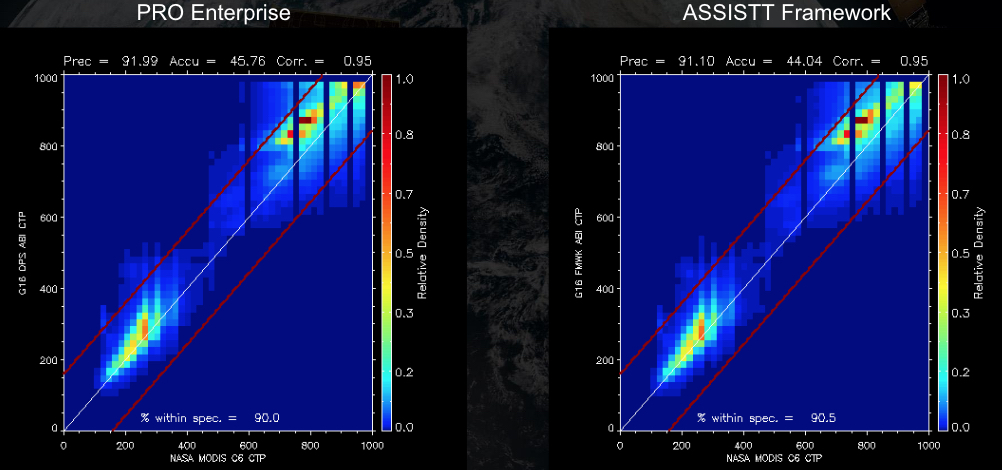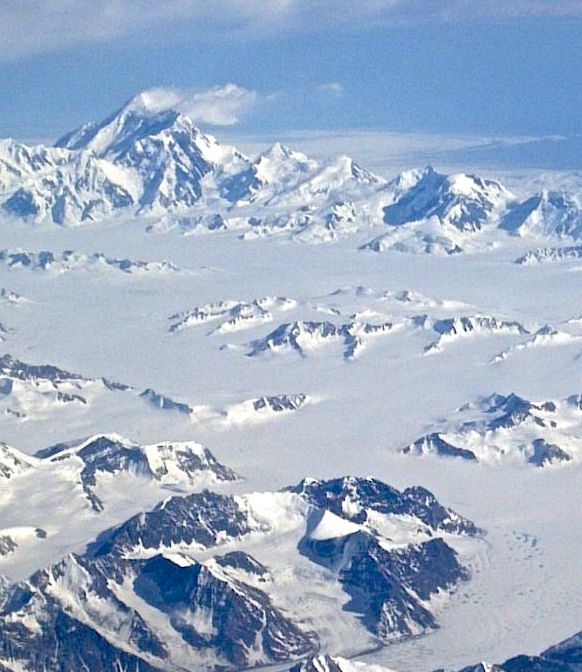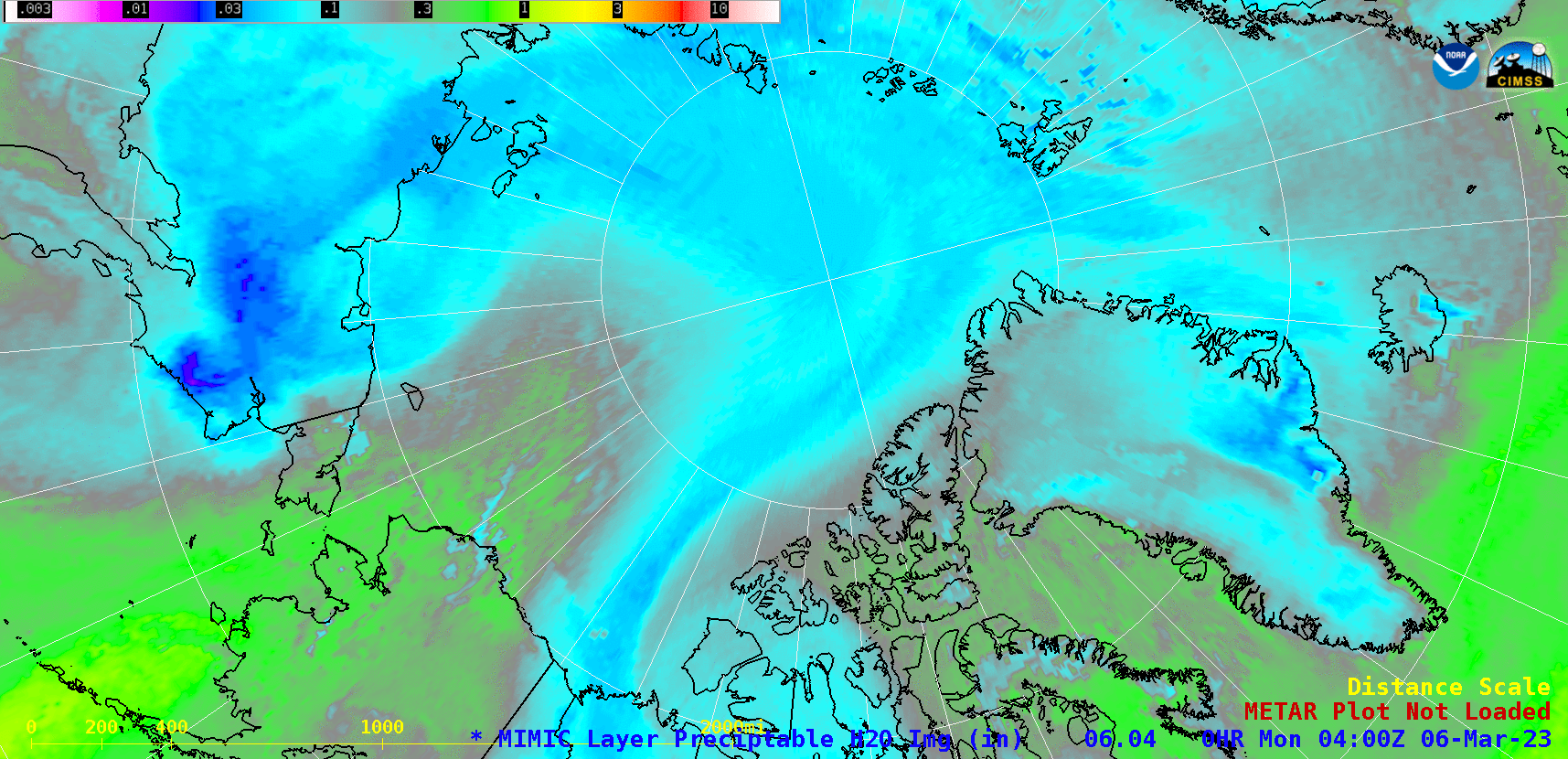
[ Archive ]

 |
CIMSS-NOAA Weekly Report [ Archive ] |
 |
CIMSS AND ASPB WEEKLY HIGHLIGHTS FOR THE WEEK ENDING MARCH 10, 2023
DATA, INFORMATION, AND USE-INSPIRED SCIENCE:
GOES-18 Cloud Product GOES Enterprise Algorithm Review: Scientists from the University of Wisconsin-Madison Cooperative Institute for Meteorological Satellite Studies (CIMSS) and the NOAA/NESDIS/Center for Satellite Applications and Research (STAR) presented to the GOES-R Enterprise Algorithm Review (GEAR) team the Enterprise Algorithm Working Group (AWG) Cloud Height Algorithm (ACHA) and Cloud Optical and Microphysical Properties (COMP) for the GOES-18 Advanced Baseline Imager (ABI). The ACHA and Nighttime COMP (NCOMP) products were shown to meet evaluation requirements without any major operational implementation issues. Artifacts within the operational Daytime COMP (DCOMP) product, however, were highlighted. These artifacts were not evident in GOES-18 products created by CIMSS scientists with the same scientific code. The team quickly determined that the artifact was caused by a relative satellite azimuth angle issue that was previously described in Algorithm Discrepancy Report (ADR) 609, but not implemented in the operational code. The operational code has been updated to rectify this issue. All GOES-18 ACHA and COMP products should be ready for operational distribution (S. Wanzong, CIMSS, 608-263-1950, A. Walther, CIMSS, 608-890-1990, W. Straka III, CIMSS, M. Foster, CIMSS, 608-261-1361, M. Kulie, E/RA2, 608-263-6583)
 (Click image to enlarge)
(Click image to enlarge)
Figure: GOES versus MODIS Cloud Top Pressure (CTP) comparisons for the Enterprise ACHA product created by the operational Ground System (left) and ASSISTT Framework (right). Both data processing systems produced similar results within evaluation specifications.
FUTURE OUTLOOK:
AWARDS AND RECOGNITION:
TRAVEL AND MEETINGS:
WMO Meetings on the Cryosphere in Earth System Models and the GCW Advisory Group: The World Meteorological Organization (WMO) Infrastructure Commission recently tasked Global Cryosphere Watch Advisory Group (GCW-AG) and the Standing Committee on Data Processing for Applied Earth System Modelling and Prediction (SC-ESMP) to coordinate the development of a roadmap for infrastructure to support the fully coupled cryosphere in Earth system models. Jeff Key (STAR) participated in the meeting as the chair of the GCW Cryosphere and Polar Observations Expert Team. The Norwegian Meteorological Institute (MET Norway) hosted the Workshop in Oslo, Norway from 6 to 8 March 2023, primarily as an in-person meeting. The GCW Advisory Group then met 9-10 March to discuss the status of the various activities and a new structure for the program. Key is a member of the GCW-AG, and presented recent progress on a task to review and revise requirements for cryosphere observations in WMO. (J. Key, E/RA2, 608-263-2605, jeff.key@noaa.gov)
 (Click image to enlarge)
(Click image to enlarge)
Figure: Wrangell Mountains, Canada and Alaska.
TRAINING AND EDUCATION:
Virtual Alaska Weather Symposia Presentation by Scott Lindstrom: Scott Lindstrom from the Cooperative Institute for Meteorological Satellite Studies (CIMSS) gave a Virtual Alaska Weather Symposia (VAWS) webinar on 8 March 2023 (VAWS Symposia are recorded and are available here: https://vimeo.com/channels/vaws.) The talk, "Forecasting at High Latitudes requires both GEO and LEO satellites", discussed the strengths of visible/infrared imagery from geostationary data, and the strengths of visible/infrared/microwave imagery from low-earth orbit satellites, and challenged forecasters to match the time and space scales of the phenomena being monitored to the most appropriate satellite observations. The Presentation is available at https://cimss.ssec.wisc.edu/training/PowerPoints/Lindstrom_VAWS_GOESandJPSS_March_08_2023.pptx. (S. Lindstrom, CIMSS, 608 263 4425)
MEDIA INTERACTIONS AND REQUESTS:
SOCIAL MEDIA AND BLOG Posts:
SSEC and CIMSS Scientists in the News: Scientists at the University of Wisconsin-Madison (UW) Space Science and Engineering Center (SSEC) and the Cooperative Institute for Meteorological Satellite Studies (CIMSS) provide expert interviews, imagery and case studies to promote science. This week: 1. Members of the NSF-funded U.S. Ice Drilling Program team at SSEC provided ice drilling field support to a Peruvian expedition to extract glacial ice cores from the Quelccaya Ice Cap. SSEC News published this story: https://www.ssec.wisc.edu/news/articles/15013. 2. CIMSS scientist Scott Bachmeier provided satellite-based information to The Hill on blowing dust that originated in New Mexico, Texas and Oklahoma and was transported to Maryland and West Virginia. Read more: https://go.wisc.edu/1q9w4i. 3. CIMSS Satellite Blog contributors Scott Bachmeier, Scott Lindstrom and Alexa Ross published these case studies: "Atmospheric river moves across the North Pole" (March 8), "Polar2Grid version 3.0 has been released" (March 8), "Cyclone Freddy Persists" (March 7), "Gridded GLM Software version 1.0 available" (March 7), "Turbulence aboard Lufthansa flight 469 from Austin TX to Frankfort" (March 6), "SAR data over American Samoa, part VII" (March 5), "Cyclone Kevin reaches Category 4 intensity" (March 4), "Severe weather (and record low pressure) across the Tennessee/Ohio Valley" (March 3). Read more at the CIMSS Satellite Blog: https://cimss.ssec.wisc.edu/satellite-blog/. (E. Verbeten, SSEC, E. Moravec, SSEC, S. Bachmeier, CIMSS, S. Lindstrom, CIMSS, A. Ross, SSEC J. Phillips, SSEC, 608-262-8164)
 (Click image to enlarge)
(Click image to enlarge)
Figure: The Morphed Integrated Microwave Imagery at CIMSS - Total Precipitable Water (MIMIC-TPW) product showed the poleward transport of an atmospheric river across Alaska, the North Pole and Svalbard (located between Norway and Greenland) on March 8, 2023. Read more at the CIMSS Satellite Blog: https://cimss.ssec.wisc.edu/satellite-blog/archives/50986. Credit: CIMSS, NOAA.
PUBLICATIONS:
OTHER:
| Archived Weeklies Page | Submit a report item |